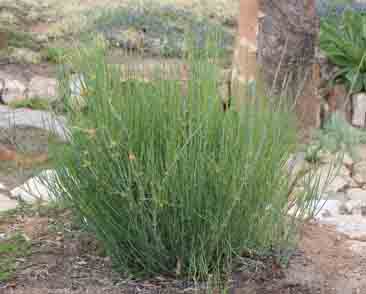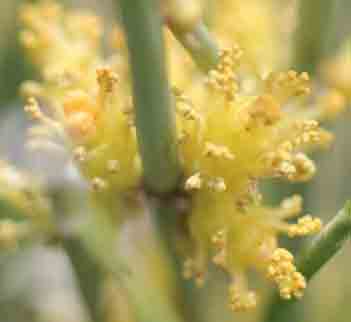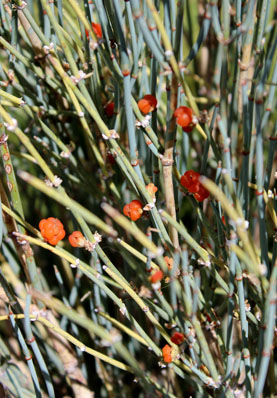The Plant

The Flowers
 |
 |
The Fruit

Description
"Ephedra is a genus of gymnosperm shrubs, the only genus in its family, Ephedraceae, and order, Ephedrales. The various species of Ephedra are widespread in many lands, native to southwestern North America, southern Europe, northern Africa, southwest and central Asia, northern China and western South America.[3]
In temperate climates, most Ephedra species grow on shores or in sandy soils with direct sun exposure. Common names in English include joint-pine, jointfir, Mormon-tea or Brigham tea. The Chinese name for Ephedra species is mahuang (simplified Chinese: 麻黄; traditional Chinese: 麻黃; pinyin: máhuáng; Wade–Giles: ma-huang; literally: "hemp yellow"). Ephedra is also sometimes called sea grape (from the French raisin de mer), a common name for the flowering plant Coccoloba uvifera." (Wikipedia)
Ethnobotanical Uses
Food:
"(Paiute) Dried twigs made into an aromatic tea. (Shoshoni) Parched, ground seeds used for coffee." (Moerman 211)
Recipe:
Mormon Tea "Harvest plenty of Momon tea, and dry in cool dark place with adequate airflow. Store dried stems in an airtight jar. The herb will remain more potent if left whole until ready to use, but it also can be ground or chopped into smaller pieces.
Place a spoonful of dried herb into a tea strainer. Add boiling water, and steep until desired strength.
Variation: Add lemon balm, clover, alfalfa, peppermint leaves, rose hips, or honey." (Morgan 143)
Medicine:
"The decongestant effects of Mormon Tea and its subdued stimulant effects seem to point to enough ephedrine-related alkaloid content to make it functional, if not for drug manufacturing, at least for home use. The tea has a pronounced diuretic effect a well, and it forms a basic remedy for Indians and Spanish-speaking peoples of the Southwest." (Moore 110)
"Tea brewed from leaves and stems has been drunk for urinary disorders at Santa Clara Acoma, and Leguna and for diarrhea at several Tewa-speaking pueblos. The tea has also been used for cough medicine at Acoma and applied as a lotion for itchy skin at Isleta. ----
Owing to the tannin in joint-fir, a powder ground from boiled plant parts has been employed during historic times by Puebloans to tan hides. The use of plant materials such as joint-fir, oak, and wild dock in tanning was learned from the Spanish. Previously, tanning was done using urine or animal brains."(Dunmire and Tierney 123)
Other Uses:
"(Havasupai) Twigs used to make drying mat for pulp." (Moerman 211)
Internet Resources